For additional information relating to this article, please contact:
September 04, 2015LABOUR MARKET TRENDS - AUGUST 2015 TRENDS
Nova Scotia's seasonally adjusted employment decreased by 1,800 in August 2015 to 447,700. This follows an increase of 3,100 jobs in July and a drop of 300 in June.
Compared to July, the labour force has decreased by 700 to 488,600. With employment falling at faster pace than labour force, the net result was a 0.3 percentage point increase in the seasonally adjusted unemployment rate to 8.4 percent in August. Because of the decrease in labour supply, the participation rate decreased by 0.1 percentage points to 62.2 per cent. The decrease in employment pushed the employment rate down 0.2 percentage points to 57.0 per cent.

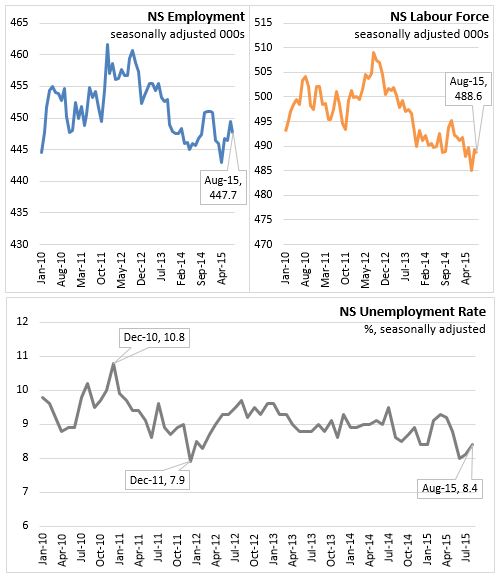
In August, the decline in employment was the net result of a reduction of 2,500 part-time jobs overriding the increase of 700 full-time jobs.
Compared with August 2014, the labour force has decreased by 100 (0.0 percent) while employment increased 1,000 (0.2 per cent). Full-time employment in August is 5,600 higher than a year ago, and part-time is 4,600 lower than in 2014. Overall, with labour demand increasing combined with a falling labour supply, the end result was a 0.2 percentage point drop in seasonally adjusted unemployment rate to 8.4 per cent.
Year-to-date
For the first eight months of 2015 compared to the first eight months half of 2014, there was a slight increase in the average employment level by 700 to 447,100. Average full time employment was up 4,500 while there were also 3,900 fewer part time workers. The labour force had a decrease of 1,200 for the first eight months of 2015. With a slight increase in labour demand coupled with a decline in labour supply, the net result was a 0.3 percentage point drop in the average unemployment rate, to 8.7 per cent. With a working age population gain of 2,300, the labour force participation rate dropped 0.3 percentage points to 62.4 per cent. The employment rate increased remained the same at 57.0 per cent.
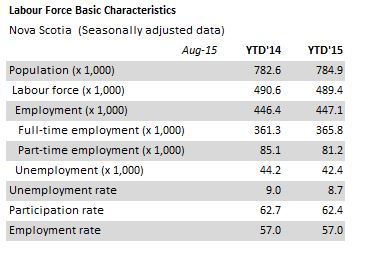
Class of Worker
Comparing the year to date employment change by class of worker, the first eight months of 2015 saw a slight increase in the overall employment level. The increase in payroll employment (2,200 employees) was offset by a drop of 1,600 among the self-employed. Employment in the public sector was up by 1,900 while the private sector had a gain of 300 jobs.
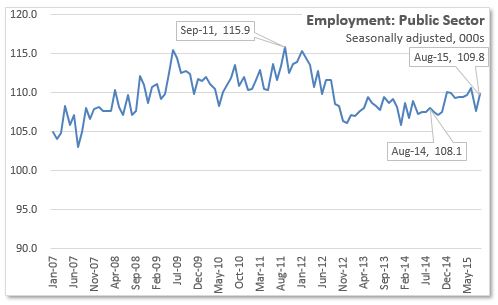


SECTORS
Comparing the first eight months of 2015 to the first eight months of 2014, employment in goods-producing sectors fell by 2,200 jobs. There were declines reported in all goods sectors except primary production. There was a net gain in employment of 2,800 in service-producing sectors. Most of the job losses were in trade (retail and wholesale) and other services.
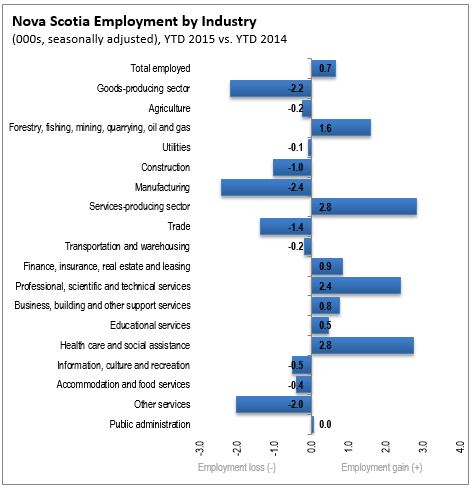
REGIONS (three month moving average unadjusted)
Halifax (HRM), Cape Breton and Southern region reported increases in employment among the province's five economic regions comparing the first eight months of 2015 over the same period in 2014. The same three regions except Southern NS also reported labour supply increases. Unemployment rates were down in all regions except Halifax (HRM).
The Cape Breton region reported an increase of 1,000 jobs comparing the first eight months of 2015 to the same period in 2014. The labour force increased by 800 jobs for the same period resulting in a slight drop to the number of unemployed workers. With labour demand growing at a slightly faster pace than labour supply, the net result was a decrease of 0.5 percentage points in the unemployment rate to 15.2 per cent.
For the North Shore region, employment decreased 600 for the first eight months of 2015 over the same period in 2014. Labour supply fell by 1,400 for the same period. The fall in both labour demand and supply caused a 0.7 percentage point decrease in the unemployment rate to 10.3 per cent.
The Annapolis Valley region experienced a drop of 2,700 in employment while the labour force had a fall of 3,700 for the first eight months of 2015 over the same period in 2014. The net result was a 1.0 percentage point decrease in the average unemployment rate to 9.1 per cent.
The Southern region saw employment increase by 1,100 and the labour force reporting a decrease of 100 for the first eight months of 2015. With the labour demand increasing at a faster pace, the end result was a drop in the unemployment rate of 2.1 percentage points to 10.8 per cent.
For the first eight months of 2015 compared to the first eight months of 2014, Halifax (HRM) experienced an increase in employment (+2,300) plus an increase of 2,900 in the labour supply. With labour supply growing at a faster pace than labour demand, the net impact was an increase of 0.2 percentage points in the unemployment rate to 6.5 per cent.
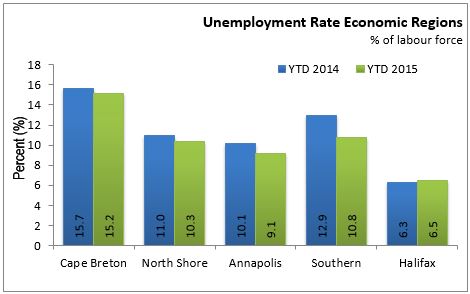
PROVINCIAL COMPARISONS
Year to date employment (average) across the country averaged 0.9 per cent growth to July 2015 compared to a year ago. Leading the country at 1.9 per cent growth is Manitoba, followed by Alberta at 1.8 per cent. Compared to the first eight months of last year, three provinces showed declines (Newfoundland and Labrador at -0.9 per cent, PEI at -1.0 per cent, New Brunswick at -0.8 per cent).

Comparing unemployment rates in August to those a year ago, Nova Scotia showed a 0.2 percentage point decrease to 8.4 per cent in August 2015. Four provinces showed declines in the Unemployment Rate compared to July 2015, the largest decline occurring in Newfoundland and Labrador.

National Comparisons: Cities
The seasonally adjusted unemployment rate for the Halifax Census Metropolitan Area fell to 5.7 per cent. Guelph (3.7%) once again had the lowest unemployment rate in Canada this month.
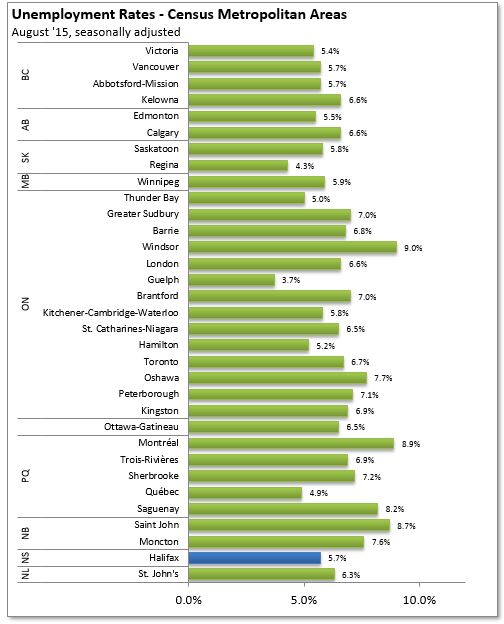
The seasonally adjusted employment rate for the Halifax Census Metropolitan Area increased to 64.4 per cent in August 2015.

Employment in the Halifax CMA was up 0.8 per cent in August 2015 compared to last month. The largest gain from month to month in CMAs was in St Catharines and in Saint John, where employment rose by 1.4 per cent in those areas, over the previous month.
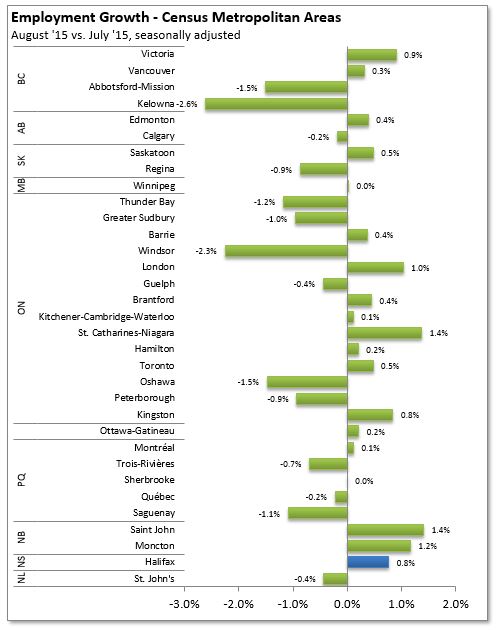
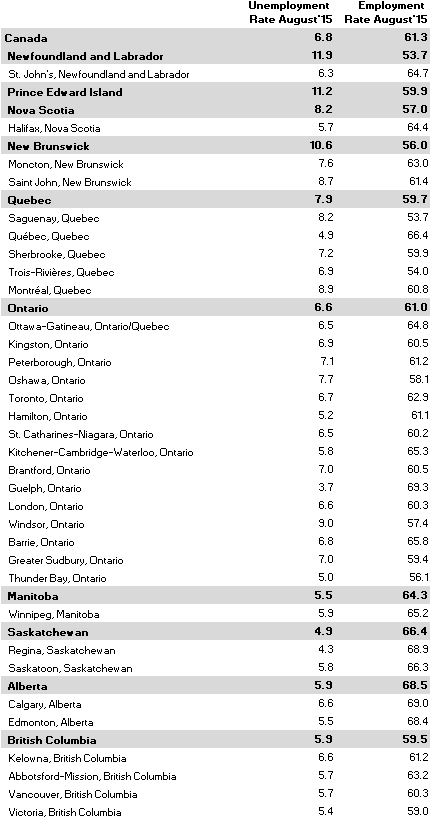
Note: Seasonally adjusted, 3 month average.